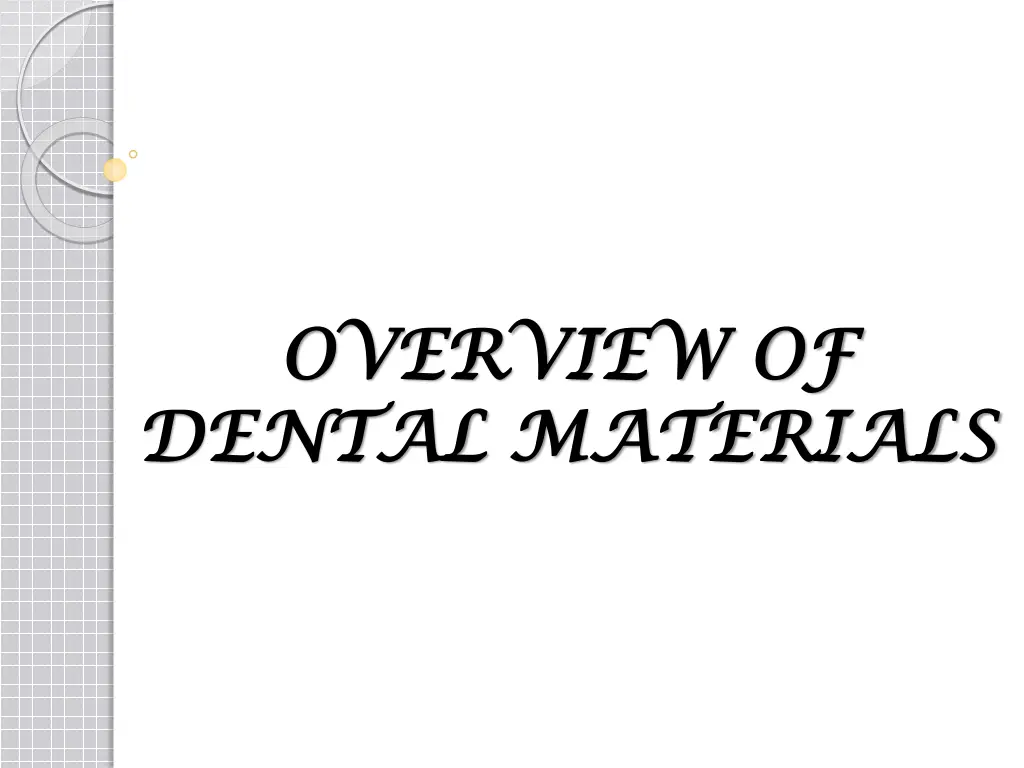
Understanding Dental Materials for Oral Health
Explore the world of dental materials used in dentistry to maintain and enhance oral health. Learn about the classification, types, and ideal properties of dental materials for preventive and restorative purposes.
Download Presentation

Please find below an Image/Link to download the presentation.
The content on the website is provided AS IS for your information and personal use only. It may not be sold, licensed, or shared on other websites without obtaining consent from the author. If you encounter any issues during the download, it is possible that the publisher has removed the file from their server.
You are allowed to download the files provided on this website for personal or commercial use, subject to the condition that they are used lawfully. All files are the property of their respective owners.
The content on the website is provided AS IS for your information and personal use only. It may not be sold, licensed, or shared on other websites without obtaining consent from the author.
E N D
Presentation Transcript
OVERVIEW OF OVERVIEW OF DENTAL MATERIALS DENTAL MATERIALS
What is Dental Material? Human body is prone to damage due to either disease or accidents. Likewise the structures in the oral cavity are lost or damaged due to disease such as caries, periodontal disease and trauma. The main goal in dentistry is to maintain or improve the quality of life through replacement or alteration of tooth structure.
s Goal can be accomplished by preventing disease, relieving pain, improving mastication efficiency, enhancing speech, & improving appearance. Therefore the main challenge for centuries has been to develop and select ideal dental materials that can withstand the adverse conditions of the oral environment.
Ideal Restorative Material Be biocompatible Should bond permanently to tooth structure or bone Should match the natural appearance of tooth structure and other visible tissues Exhibit properties similar to those of tooth tissues (enamel and dentine) Be capable of initiating tissue repair or regeneration of missing or damaged tissues
DENTAL MATERIALS Metals Ceramics Polymers Composites
Classification Preventive dental materials Restorative dental materials Auxiliary dental materials
Preventive Dental Materials Pit and Fissure Sealants Sealing agents that prevent leakage Materials used primarily for their antibacterial effects. Liners, bases, cements and restorative materials that are used primarily because they release fluoride. Chlorhexidine or other therapeutic agents used to prevent or inhibit the progression of tooth decay.
Restorative Dental Materials Synthetic components that can be used to repair or replace tooth structure, including primers, bonding agents, liners, cement bases, amalgams, resin-based composites, compomers, hybrid ionomers, cast metals, metal-ceramics, ceramics, and denture polymers.
Restorative Dental Materials Direct restorative materials Used intraorally to fabricate restoration or prosthetic devices directly on the teeth Indirect restorative materials Made extraorally in which the materials are formed indirectly on the teeth or tissues Temporary restorative materials
Auxiliary Dental Materials Substances used in the process of fabricating dental prostheses and appliances but do not become part of these devices. Acid etch solutions, impression materials, casting investments, gypsum cast, and model materials, dental waxes, acrylic resins for impression, bleaching trays, mouthguards, and occlusion aids, finishing and polishing abrasives.
Terminologies Restoration- filling material or prosthesis used to restore or replace a tooth, a portion of a tooth, multiple teeth, or other oral tissues
Base- layer of insulating, sometimes medicated, cement, placed in the deep portion of the preparation to protect pulpal tissue from thermal and chemical injury Cement- substance that hardens to act as a base, liner, filling material, or adhesive to bind devices and prosthesis to tooth structure or to each other
Zinc polycarboxylate cement Zinc Phosphate cement
Cavity liner- thin layer of cement, such as Ca(OH)2 suspension in an aqueous or resin carrier(after evaporation)used for protection of the pulp. certain glass ionomer cements that are used as an intermediate layer between tooth structure and composite restorative material are also considered liners.
Intermediate restorative material Zinc oxide eugenol
DIRECT RESTORATIVE MATERIALS Amalgam Liners and bases Varnishes, calcium hydroxide, zinc oxide eugenol, zinc phosphate, zinc polycarboxilate, glass ionomer cement Pit and fissure sealants Composites Glass ionomer cement Direct filling gold
Properties of dental materials Coefficient of thermal expansion Contact angle Strength- - Compressive strength - Tensile strength - Shear strength Modulus of elasticity Abrasion resistance biocompatibility
Amalgam Compressive strength Tensile strength Creep Dimensional stability Tarnish and corrosion expansion
Composites Compressive strength Tensile strength Modulus of elasticity esthetics Polymerization shrinkage Modulus of elasticity biocompatibility
INDIRECT RESTORATIVE MATERIALS Impression materials Cast metal restorations Ceramic restorations Cementation materials






















